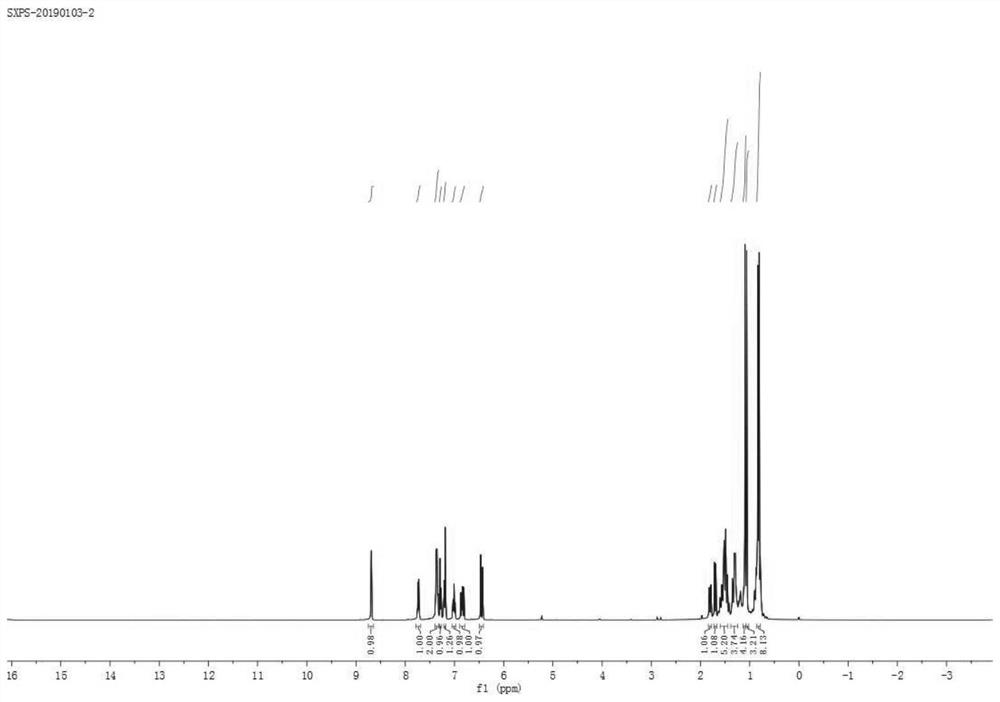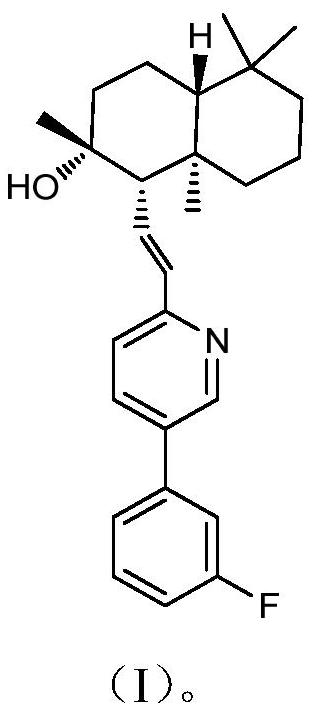Novel PAR-1 inhibitor and preparation method thereof
A PAR-1, inhibitor technology, applied in pharmaceutical formulations, medical preparations containing active ingredients, extracellular fluid diseases, etc., can solve problems such as low activity, achieve high activity, high safety, and easy industrialized mass production Effect
- Summary
- Abstract
- Description
- Claims
- Application Information
AI Technical Summary
Problems solved by technology
Method used
Image
Examples
Embodiment 1
[0032] The preparation method of the described novel PAR-1 inhibitor (compound I), the concrete steps are as follows:
[0033] (1) Preparation of compound V
[0034] Weigh 8.40 g of sclareolide into a round-bottomed flask, add 143 mL of formic acid (99%) and 6 mL of concentrated sulfuric acid (93%) in turn, stir at room temperature for 3 h, then quench the reaction with ice water, extract with 200 mL of ether, The organic phase was sequentially washed with saturated sodium bicarbonate and saturated brine. The organic phase was dried by adding anhydrous sodium sulfate, filtered, and the solvent was removed under reduced pressure to obtain compound II as a white solid. It was dissolved by adding 150 mL of tetrahydrofuran. Then, 50 mL of a 1 M solution of potassium hexamethyldisilazane in tetrahydrofuran and 5.6 mL of trimethoxyphosphorus were slowly added to the round-bottomed flask. Finally, oxygen was introduced to react at -78°C. After the reaction was completed, the system...
Embodiment 2
[0041] The preparation method of described novel PAR-1 inhibitor (compound I), concrete steps are as follows:
[0042] (1) Preparation of Compound V
[0043] Weigh 200g of sclareolide into a round bottom flask, add 3.4L of formic acid (99%) and 143mL of concentrated sulfuric acid (93%) successively, stir at room temperature for 3h, then quench the reaction with ice water, extract with 4.5L of ether , the organic phase was sequentially washed with saturated sodium bicarbonate and saturated brine, the organic phase was dried by adding anhydrous sodium sulfate, filtered, and the solvent was removed under reduced pressure to obtain white solid compound II. 3.4 L of tetrahydrofuran was added to dissolve it. Then, 1.2 L of a 1M tetrahydrofuran solution of potassium hexamethyldisilazane and 134 mL of trimethoxyphosphine were slowly added to the round bottom flask in sequence. Finally, oxygen was introduced and reacted at -78°C. After the reaction was completed, the system was lower...
Embodiment 3
[0047] Determination of biological activity (PAR-1 inhibitory activity) of compounds
[0048] 1. Cell culture
[0050] The HEK293-Gα15-PAR1 cell line (HDBiosciences stable cell line) was quickly taken out of the liquid nitrogen tank, and kept shaking in a 37°C water bath until it completely melted. The cell suspension was quickly added to the preheated medium (90% DMEM+10% FBS+1XPen / Strep), put into a centrifuge, and centrifuged at 1000 rpm for 10 minutes. Take out the centrifuge tube, discard the supernatant, add fresh preheated medium to the centrifuge tube, resuspend the cells, add the cell suspension to the culture dish, 37°C, 5% CO 2 nourish.
[0051] 1.2 Subculture
[0052] When the cells grow to 80-90% of the culture dish, gently wash the cells with 0.05% trypsin-EDTA, remove part of the digestion solution and incubate for 2-3 minutes, stop the digestion with a new medium, blow the cells gently with the tip of the pipette and Cells are re...
PUM
 Login to View More
Login to View More Abstract
Description
Claims
Application Information
 Login to View More
Login to View More - R&D
- Intellectual Property
- Life Sciences
- Materials
- Tech Scout
- Unparalleled Data Quality
- Higher Quality Content
- 60% Fewer Hallucinations
Browse by: Latest US Patents, China's latest patents, Technical Efficacy Thesaurus, Application Domain, Technology Topic, Popular Technical Reports.
© 2025 PatSnap. All rights reserved.Legal|Privacy policy|Modern Slavery Act Transparency Statement|Sitemap|About US| Contact US: help@patsnap.com



